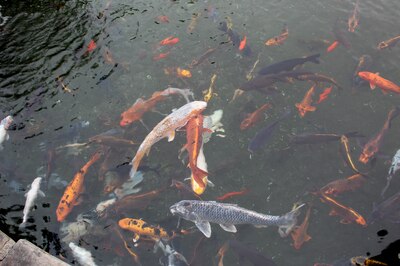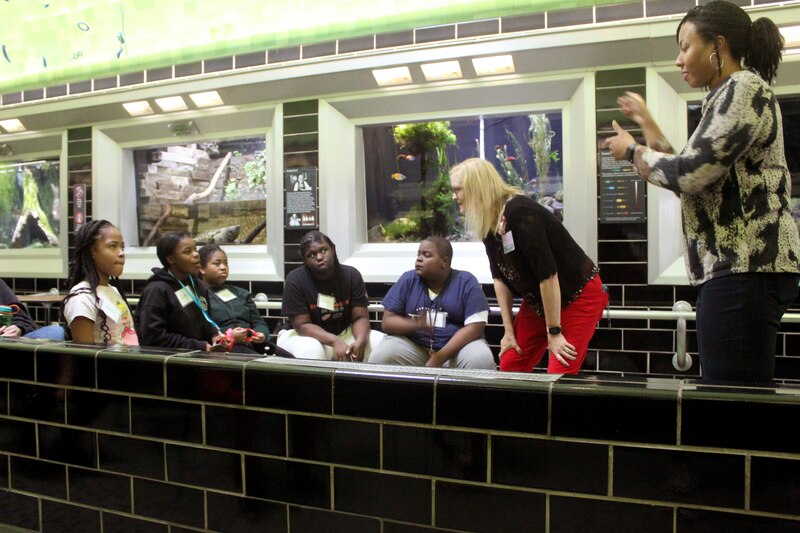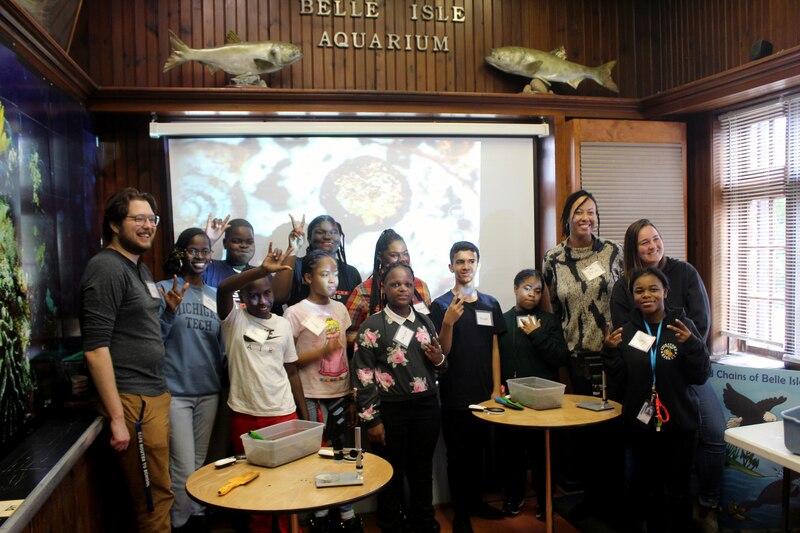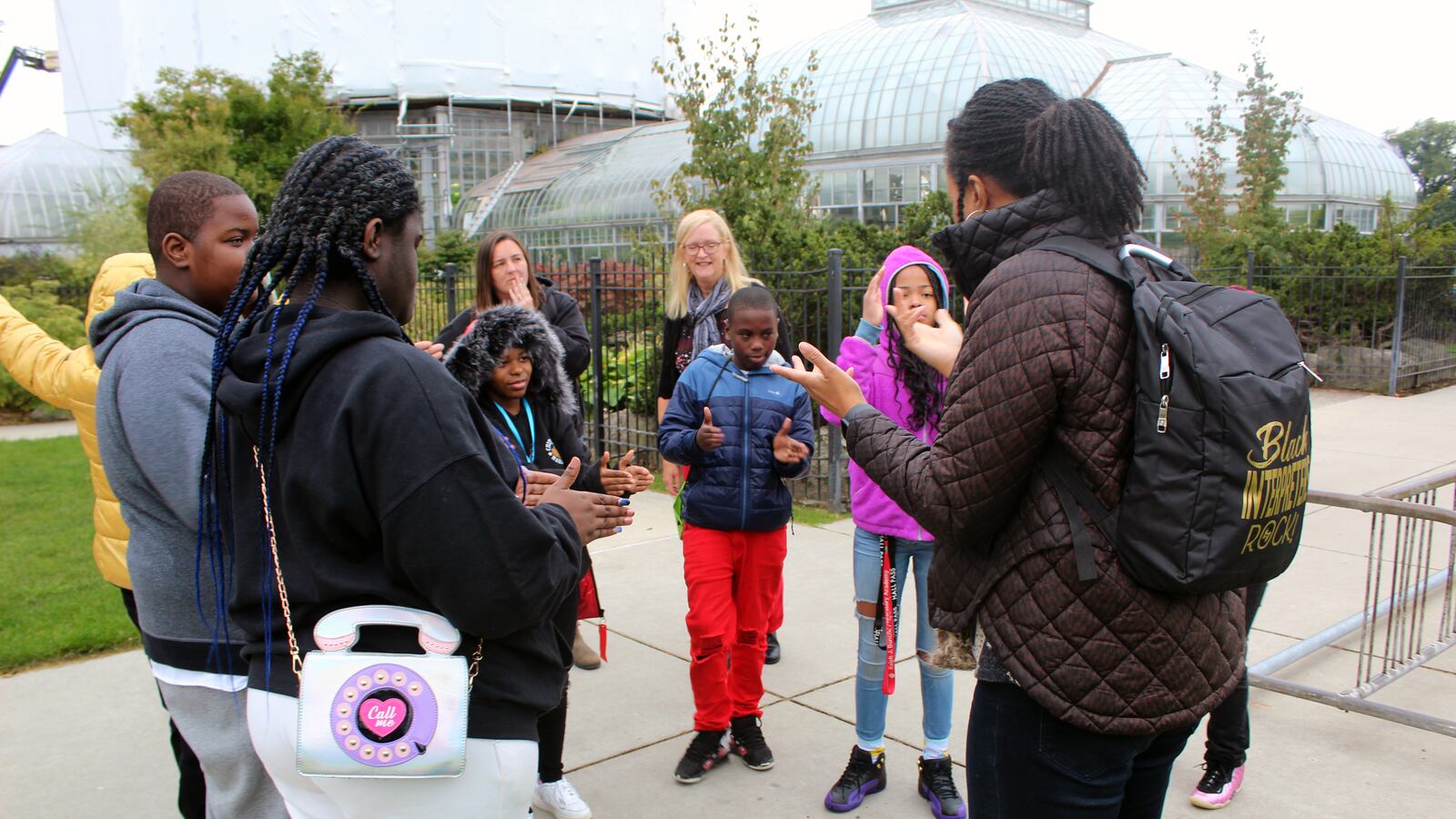As dozens of koi swam around a pond, a group of Detroit elementary and middle school students let out a chorus of oohs and aahs. Up close, the carp were dazzling — some with orange and white patterns, others painted yellow and with black spots.
Peeking over the metal railing along the koi pond, the students peppered their instructor with questions.
“What do they eat?”
“How long do they live for?”
“How do fish get pregnant?”
Kids can get awfully curious in the presence of nature. And that was the point of this exercise on a cloudy October morning, far away from the classroom.
The students were taking part in a weeklong lesson at Detroit’s Belle Isle Aquarium and Nature Center designed to help them investigate the natural wonders at the city park.

At a time when school leaders are grappling with the academic and emotional repercussions of the pandemic and waning engagement in the classroom, more educators are embracing immersive place-based learning as a way to capture the interests and curiosity of their students.
The case for nature- and place-based learning is growing, with more research arguing that such opportunities can provide students with a host of positive outcomes, such as increased motivation, improved critical thinking, and stronger student-teacher relationships.
In Detroit, former Michigan Teacher of the Year June Teisan has been working with the Detroit Public Schools Community District over the past year to provide students with hearing disabilities the opportunity to visit and explore Belle Isle, a vast island park that many young Detroit residents consider inhospitable or inaccessible.
Every day over the past two weeks, students in grades 1-8 from Detroit’s Bunche Preparatory Academy were bused to Belle Isle for the field trips.
“So many of us just take for granted having access to nature, and the mental and physical health benefits of understanding the outdoors,” said Teisan, a retired teacher and founder of the nonprofit InnovatED (313).
“Not everybody’s going to love bugs like I did, or not everybody’s going to enjoy reading a book here and there,” Teisan said. “But connecting with (students) and understanding more about them and saying, ‘How can I meet the needs, the interests and the passions that you bring with you?’ is important.”
The field trips take inspiration from the Big Lesson, a similar program started by fellow Teacher of the Year Margaret Holtschlag that serves students across mid-Michigan.

Outside learning piques student curiosity
That day at Belle Isle, students armed with a magnifying glass, a plastic spoon, and a pipette began to inspect Petri dishes full of water collected from the nearby marina. Almost immediately, they discovered mayflies and dragonflies.
“This is what ducks and fish are digging for. This is what they eat,” said Amy Emmert, director of education at the Belle Isle Conservatory and the instructor for the week’s lessons.
The lesson was exciting for eighth grader Husam Alnsiwi, who hopes to one day become a scientist.
“I know there’s writing involved, but I want to study chemistry and learn about real things and experimenting,” he said.
The students are accompanied by a classroom teacher and a group of sign-language interpreters. Teachers say the weeklong lesson is an important opportunity to expose students to what’s available in their own community and include them in activities that often are not tailored to their needs.
“Our teachers have said that this helps them,” Teisan said. “When kids are this excited, you can more easily say, ‘Now let’s write some of these words together. Let’s compose sentences about what our experience was.’’’
Teisan balanced trips with test prep
Teisan, who describes herself as “the kid who laid on her stomach and on the sidewalk looking at ants and chewing on bubblegum,” turned her early curiosities into a lifelong commitment to increasing youth interest in the sciences.
“I had the best job because I had the most toys,” she said of her 27-year tenure as a science teacher in Harper Woods, a city on the northeast border of Detroit.
In her role as an educator, she bridged the gaps between her students and the surrounding community, whether conducting history lessons inside the Detroit Institute of Arts or accompanying experts from the Audubon Society for bird-watching expeditions.
“Teachers are the ones I think who can build those connections when we’re not so busy doing standardized test prep,” Teisan said. “I caught a lot of flak from some administrators because I was not as into test prep, but what I was into is connecting with students and making learning engaging and tied to more of their interests.”

Later that day, students got out their black-and-white journals and began to take notes on the creatures they saw at the aquarium, sitting down in front of the animal of their choice to draw a picture and write down their observations.
With hundreds of species to pick from, Husam chose to write about the clownfish and blue hippo tang, a pair made famous by the lead characters in the Pixar film “Finding Nemo.”
“I imagined I was one of them. I feel like I’m really popular,” he said. “I’m in the movies, so you know who I am.”
Ethan Bakuli is a reporter for Chalkbeat Detroit covering Detroit Public Schools Community District. Contact Ethan at ebakuli@chalkbeat.org.

